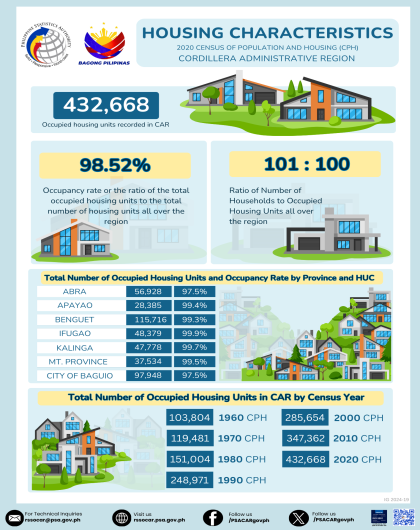| Census Year | Census Reference Date | Population |
|---|---|---|
| 2010 | May 1, 2010 | 29,596 |
| 2015 | August 1, 2015 | 32,026 |
| 2020 | May 1, 2020 | 34,275 |
From 2015 to 2020, the annual population growth rate of Pinukpuk is 1.44 percent, lower by 0.07 percent as compared from 2010 to 2015 with 1.51 annual population growth rate. (Table 2)
Table 2. Annual Population Growth Rate: Pinukpuk, Kalinga
| Reference Period | Annual Population Growth Rate (in percent) |
|---|---|
| 2010-2015 | 1.51 |
| 2015-2020 | 1.44 |
The municipality of Pinukpuk is composed of 23 barangays. Among the 23 barangays, 21 barangays or 91.30 percent increase in population as compared to 2015 population and three (3) barangays were decreased. These were barangays Ballayangon from 1,508 persons in 2015 to 1,422 persons in 2020, Bayao from 2,084 persons in 2015 to 2,028 persons in 2020 and Magaogao from 907 persons in 2015 to 794 persons in 2020. There were 17 barangays that have more than 1000 population in 2020. Barangay Asibanglan has exactly 1000 population in 2020 and there was no barangays that have less than 500 population. (Table 3)
Table 3. Population by Barangay: Pinukpuk, Kalinga
| Barangay | Population | ||
|---|---|---|---|
| 2010 | 2015 | 2020 | |
| Aciga | 753 | 883 | 1,071 |
| Allaguia | 1,607 | 1,640 | 1,648 |
| Ammacian | 1,526 | 1,756 | 1,835 |
| Apatan | 1,802 | 2,067 | 2,249 |
| Ba-ay | 644 | 534 | 557 |
| Ballayangon | 1,458 | 1,508 | 1,422 |
| Bayao | 1,826 | 2,084 | 2,028 |
| Wagud | 1,036 | 1,078 | 1,121 |
| Camalog | 848 | 859 | 1,035 |
| Katabbogan | 1,682 | 1,773 | 1,890 |
| Dugpa | 1,130 | 1,147 | 1,339 |
| Cawagayan | 880 | 1,049 | 1,183 |
| Asibanglan | 1,058 | 970 | 1,000 |
| Limos | 843 | 825 | 992 |
| Magaogao | 803 | 907 | 794 |
| Malagnat | 1,690 | 1,869 | 2,133 |
| Mapaco | 852 | 877 | 988 |
| Pakawit | 999 | 1,020 | 1,092 |
| Pinukpuk Junction | 2,986 | 2,989 | 3,337 |
| Socbot | 1,287 | 1,736 | 1,917 |
| Taga (Pob.) | 2,178 | 2,488 | 2,541 |
| Pinococ | 683 | 789 | 848 |
| Taggay | 1,025 | 1,178 | 1,255 |
Among the 23 barangays in the municipality of Pinukpuk, the largest in terms of population size is Pinukpuk Junction with 3,337 persons. It was followed by Taga (Pob.) with 2,541 persons, Apatan ranked 3rd with 2,249 persons, Malagnat with 2,133 and Bayao with 2,028. The combined population of these five barangays accounted for about 35.85 percent of the total population of Pinukpuk in 2020. (Table 4)
Table 4. Top Five Most Populous Barangays: Pinukpuk,, Kalinga
| Barangay | 2020 Population |
| Pinukpuk Junction | 3,337 |
| Taga (Pob.) | 2,541 |
| Apatan | 2,249 |
| Malagnat | 2,133 |
| Bayao | 2,028 |
Barangay Ba-ay was the least populous barangay in the municipality of Pinukpuk with 557 persons. It was followed by Magaogao with 794 persons, Pinococ ranked 3rd with 878 persons, Mapaco with 988 persons, Limos belongs to top five least populous barangays with 992 persons. (Table 5)
Table 5. Top FiveLeast Populous Barangays: Pinukpuk, Kalinga
| Barangay | 2020 Population |
| Ba-ay | 557 |
| Magaogao | 794 |
| Pinococ | 878 |
| Mapaco | 988 |
| Limos | 992 |
The total land area of Pinukpuk is 743.56 square kilometers and the population density of Pinukpuk in 2020 was posted at 46 persons per square kilometer. This represents an increase of three (3) persons per square kilometer in five (5) years time. In 2010, there were about 40 persons in every square kilometer of land in the municipality (Table 6)
Table 6. Population Density: Pinukpuk, Kalinga
| Census Year | Population Density (Persons Per Square Kilometer) |
|---|---|
| 2010 | 40 |
| 2015 | 43 |
| 2020 | 46 |
The population figures in this report were based on the results of the 2020 CPH. The land areas were based on the 2013 Masterlist of land Areas of Cities and Municipalities provided to the Philippine Statistics Authority (PSA) by the Land Management Bureau (LMB).


